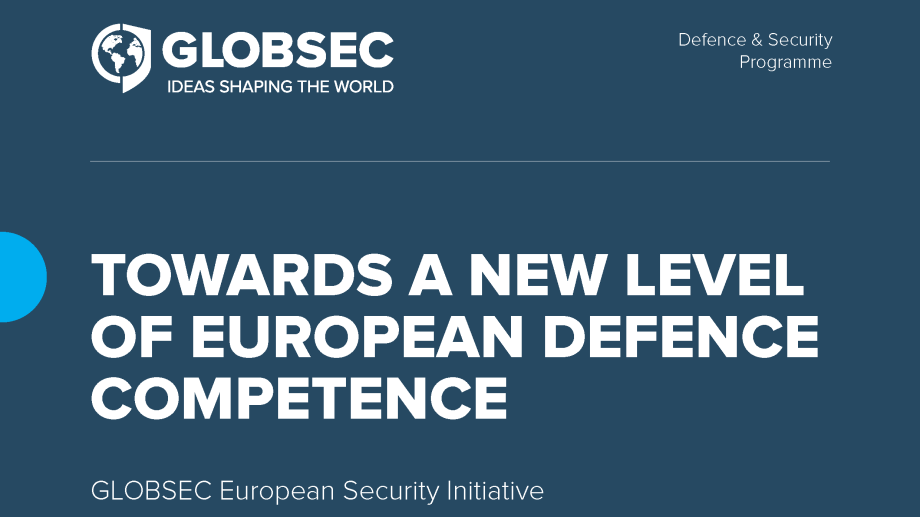Towards a new level of European Defence Competence

This report highlights the central findings and recommendations of the GLOBSEC European Security Initiative (GESI). GESI, led by General (Ret.) Knud Bartels aims to critically analyse the current state of development of European Defence capabilities and put forward a strategic vision of European Defence in light of this context.
In the authors’ opinion, the concept of European Defence cannot be confined solely to the EU. The European security sphere encompasses all European countries, the EU and the non-EU Member States alike, and it is tightly knitted with transatlantic security.
The full report is available here
Executive summary: Key recommendations
The case for the development of a robust system of European Defence has become resounding over the past few decades. There is little, if any, opposition towards this overarching aim. The main stakeholders in Europe and allies across the Atlantic agree that Europeans need to enhance the region’s defence and security capacities, currently only partially developed. For the last two years, if not longer, this stance has come to constitute mainstream thinking and inform policy formulations in the region. Despite these uniform aspirations, the enactment of this vision has, nevertheless, lagged behind in terms of tangible outputs. The devil is not simply in the details but rather in the entire implementation process. A structural shortfall in capabilities, in particular, continues to hinder European Defence from materializing. Endeavours to narrow this capabilities gap, in turn, have encountered other underlying problems. To overcome political and budgetary constraints, European Defence needs all the concrete inputs it can get. A number of critical players are involved: the Atlantic Alliance, the European Union, individual countries, and the defence industry. It is crucial that all of them “own” European defence and become part of the process, as incremental as that might be, of building it.
The cumulative efforts of these different actors must never lose sight of the ultimate goal: enhancing the European role in ensuring security in the Euro-Atlantic space and in its neighbourhood. To this end, the European Union needs to bolster its commitment to contribute to European Defence in full synergy and coordination with NATO and in close and open cooperation with non-EU European countries and allies, in particular the post-Brexit United Kingdom.
The ultimate goal of European Defence should not be the ‘’DeNATOization of Europe’’ but rather a “Europeanization of NATO” that strengthens the Atlantic Alliance. The rationale for moving forward is self-explanatory: prosperous democracies must be capable of adequately protecting themselves and their citizens from external threats. Security cannot be fully subcontracted – even to a staunch and reliable ally. However, European Defence needs NATO and will not be credible without NATO at its core. The more European Defence in NATO, the more NATO will defend Europeans.
To achieve this goal, the EU and its allies should adopt the following measures:
1) Keeping in mind strategic framework: not undermining the role of NATO
For most EU member states, NATO represents the primary mechanism of European security and, despite the sometimes testy rhetoric employed, EU members are not in practice interested in undermining NATO’s position. NATO and the EU are not rivals; they are partners whose roles are in fact complementary. NATO is to remain the “cornerstone” of European collective security.
The unguarded talk of developing a European ‘strategic autonomy’ or a ‘European army’, even if well-intended and often misunderstood, serves to antagonize the United States. It, moreover, comes to be immediately politicized domestically in EU member states and mobilise sectorally (e.g. defence establishment) scorn and opposition to the EU’s Common Security and Defence Policy (CSDP).
2) Enhancing EU-NATO cooperation
NATO-EU cooperation is the lynchpin of European defence and European defence is larger than the EU. In recent years, both NATO and the EU have done much to overcome inter-institutional tensions, as also is apparent in the declarations adopted at NATO’s Warsaw summit in 2016. However, problems with the use of the Berlin Plus mechanism have not been addressed nor is there any agreement on the different role specializations between the two organizations.
EU leaders should do more to overcome the objections of Cyprus, a country that is not a NATO member or strongly involved in CSDP. At the same time, the EU should strive to enhance Turkey’s status in CSDP. Ankara’s drift from the western milieu, nevertheless, may hinder Turkey from pursuing greater engagement in EU Security and Defence Policy.
While the EU should not confine itself to predominantly civilian missions, there is no denying that the EU, rather than NATO, is better equipped to perform such tasks. Up to now, the majority of EU operations have been civilian, focused on tasks (e.g. border monitoring or election facilitation) that NATO could not perform and operating in areas where for various reasons NATO does not operate (RD Congo, Chad, Georgia, Egypt-Gaza border). The security problems arising from the South, by no means negligible, involve non-state actors. Solutions cannot be found solely in the use of traditional military deterrence; any solution must be able to confront an array of complex issues related to state governance, political instability, and economic development. NATO cannot go it alone in the South. The European Peace Facility will allow the EU to be actively engaged in geographical areas (Africa) where NATO is conspicuously absent. At the same time, it is apparent that NATO’s ability to perform military missions is not matched by the EU. In this vein, there is ample space for a greater refining of roles specialization between the EU and NATO that would, in fact, buttress inter-institutional synergy.
3) Augmenting EU security role in light of changing global realities
The EU must come to terms with a changing global political terrain. Looking ahead, European security arrangements should heed the world’s rapidly changing strategic context. In a scenario of heightened military confrontation between the US and China in the Indo/Pacific arena and a consequent US military pivot to Asia, the responsibility for countering Russia in the Atlantic/Arctic area would rest primarily on the shoulders of European allies and Canada. This division of labour, fully consistent with the Washington Treaty, can only be effectively implemented through the gradual build-up of a credible European Defence system. The EU should augment its security role by developing autonomous military capabilities that would enable European countries to successfully confront a range of security challenges without NATO support.
4) Moving forward in measured steps and defining the scope of ambition
European strategic autonomy and a Europe more proactive on security can only be achieved by taking measured steps to develop defence capabilities. The upcoming EU debate on “strategic autonomy” risks being misunderstood and the label has already brought political drawbacks with its use. The concept is misleading when used to convey the message that its goal is to make Europe capable of defending itself against any threat, including Russia, without non-European (aka American) engagement. It is not a realistic objective and it will not happen any time soon.
What “strategic autonomy” should be about is providing Europeans with the capabilities that they currently do not possess or maintain in only a limited manner. This includes the capability of engaging in high-intensity operations over an extended period of time. The concept, in other words, should be about underscoring the European Union need to develop military capabilities that will allow European countries to address certain security challenges without NATO.
5) Holding open the door for non-EU countries
The EU needs to be inclusive and maintain an open door to the participation of non-EU Member States (e.g. the UK, Turkey, Norway, and Iceland) in its initiatives (PESCO, EDF). All of these countries bring key strengths and regional or topical expertise that the European Union cannot ignore. Concrete platforms and structures need to be developed to encourage and facilitate future cooperation with these countries.
The situation in Turkey, meanwhile, needs to be addressed effectively to maintain the country’s status as a key ally on the border between Europe and the Middle East.
6) Keeping the UK engaged
Whichever way European Security and Defence evolve, the EU’s military capability will be severely crippled if British participation is not secured. Without the United Kingdom, the EU will lose around a quarter of its overall military capabilities (not to mention one of its two nuclear powers and Permanent Members of the UN Security Council). In light of these facts, full-fledged UK participation should be pursued through either the creation of a larger than EU security sphere that would also include countries like Norway and Turkey or an EU-UK bilateral agreement.
The EU should, therefore, in spite of Brexit, propose the continuation of the UK’s strong involvement in CSDP. As declared by British Prime Minister Boris Johnson, ‘the UK is leaving the EU not Europe’ and there is no doubt that both the EU and the UK would benefit from maintaining British involvement in CSDP. The UK would remain engaged in those aspects of European security that do not affect its sovereignty and in the process, London’s isolation would be curtailed following its withdrawal from the EU. At the same time, the EU would benefit from the engagement of one of the two strongest militaries in Europe.
7) Reassuring Central Europe – reinforcing defence
In order to secure a serious commitment from the 11 Central European Member States, the CSDP must offer a credible mutual-defence component. Central European countries approach the CSDP with scepticism - to a large degree driven by their histories of subjugation to the interests of larger neighbours. This history has taught Central Europeans to be wary of alliances that do not provide them with credible defence. Central European countries are now more open to investing in European Defence integration but with the clear stipulation that the new mechanisms will not undermine their relations with the US and will not duplicate NATO.
As of today, the CSDP is really about (mostly soft) security for non-EU states – and only minimally about defence for member states. The EU should, therefore, consider developing adequate reassurance measures that recognise the vulnerability and threat perception of member states located in proximity to Russia.
The complementarity of EU defence initiatives with NATO needs to be repeatedly stressed and proven on the ground. The framing of EU defence integration in strategic autonomy terms is counter-productive and contributes to unnecessary reticence in Central Europe.
8) Enhancing Central European regional defence integration
The V4 nations should take their cooperation beyond the EU battle group and consider, for example, joint acquisition of ammunition and other equipment. The nations of the former Yugoslavia (Croatia, Montenegro, North Macedonia, and Slovenia) should combine forces in training, acquisition, and maintenance. Similar practices are already carried out by the Baltic states and by other countries in geographically or otherwise defined small groups. In acting as a group or a collection of groups, Central European countries can save precious resources and further gain improved opportunities for amplifying their voices and influencing the future direction of European Defence Integration.
9) Providing for a Euro-deterrent
The arms-control regime has reverted back to the Cold War era and Europe is again vulnerable and not sufficiently protected in the event of a nuclear conflict. The past years have witnessed the unravelling of the arms-control regime - a source of stability and predictability in the post-Cold War world - that had been set up by nuclear powers. In 2002, the United States unilaterally withdrew from the Anti-Ballistic Missile Treaty. Meanwhile, Russia violated the Intermediate-range Nuclear Forces Treaty (INF) by deploying the SSC-8, a nuclear-capable missile, to which the US responded by withdrawing from the INF Treaty.
In light of this context and the fact that the EU is unable to impact US decision-making on the arms control regime, the need for Europe to decrease its own vulnerability and provide for the continent’s deterrence is apparent now. This would require that Europe’s two nuclear powers, France and the UK, strengthen their bilateral cooperation and declare their intention to protect the rest of the continent. This would undoubtedly require the UK to remain engaged in European security after leaving the EU.
10) Calibrating open-ended and flexible instruments of engagement
Open-ended/flexible initiatives such as E2I (European Intervention Initiative) can bring substantial contributions and serve as useful instruments for binding the UK (and Denmark) to the notion of European defence and are to be encouraged. Limiting participation in this initiative may also prove reasonable given the desire to keep this structure light and task-oriented. However, by excluding almost all Central European countries (with the exception of Estonia) from this initiative, the message was conveyed that this instrument is political rather than pragmatic in nature. None of the most military capable states in the region were invited to join this framework. This should be re-evaluated in the future.
11) Focusing on deliverables and implementable initiatives
In order to gauge the European Union’s role in defence and security, the focus must shift away from a teleological debate and instead emphasize pragmatic endeavours. This includes identifying the deliverables of an array of new initiatives that are moving from the pipeline to implementation with the von der Leyen Commission. The Trans-European Transport Network is an example of such an indispensable contribution to European security and to NATO’s goals.
12) Translating European commitments into national implementation
European governments have, in fact, agreed to do quite a few things on defence, witness progress being made with the Permanent Structured Cooperation (PESCO). Member States now have to deliver on their commitments by embedding those promises, policies, and processes at home in their national defence establishments and among their military planners.
13) Amplifying EU capacity for military action
While the EU should not compete with NATO in taking on tasks that involve military operations, it should attain the ability to act when NATO is constrained or unable to act. The setting up of the Military Planning and Conduct Capability (MPCC) is certainly a step in the right direction. After years of disputes and controversies (dating back to 2003), the EU finally acquired the capacity to plan limited operations. As of today, the MPCC is limited to the conduct of operations that require up to 2500 troops (the size of a battle-group) and its mandate is hampered by time constraints for operations outside the scope of host nation support. These constraints should be lifted and the size and role of the MPCC expanded. These changes would enable the MPCC to become a comprehensive military headquarters for the conduct of EU operations.
Since 2007, the EU has maintained a rotating battle-group, a high readiness battalion reinforced with combat elements, at standby, ready to be deployed for violence-mitigation purposes in conflict zones. However, as of today, not a single battle-group has actually been deployed in a conflict area, largely on account of existing political constraints within member states. This situation has led to extensive criticism of the battle-group concept, which requires keeping a said number of troops in readiness, in the process sapping national defence resources without producing tangible results. The concept of the EU battle-group must be reformed so that the units become truly operational and deployable in conflict areas. Moreover, in addition to their role in aiding conflict-resolution, the battle-groups should be conferred an expanded mandate that also includes defensive tasks.
14) Standardising equipment
It is imperative that measures are approved to promote and encourage standardisation for economic and strategic reasons. Increased defence expenditures will be paramount, especially for countries that lag behind the NATO target of 2% of GDP spent on defence. However, it will not be sufficient if issues related to defence spending efficiency (procurement, mobility, standardization, coordination, etc...) are not adequately addressed and if the EU industrial base is not consolidated and strengthened. Benefiting from economies of scales, standardised equipment would be cheaper with a clear benefit for domestic arms industries in member states. Standardised equipment would also allow for greater cross-national cooperation, avoiding duplication and promoting better use of existing resources. Standardisation would, moreover, ensure better interoperability between European and NATO forces.
- Europeans need to spend more and better on defence and security.
It will only be sustainable if the European defence industry is a beneficiary and if the EU industrial base is consolidated and strengthened, notably through the European Defence Agency’s (EDA’s) current endeavours and the financial resources of the new European Defence Fund (EDF). Currently, divergent strategic priorities and pressure from domestic interest groups are preventing tangible progress in the standardization process. To address these concerns, Member States have to be ensured that their divergent strategic priorities will not be affected. In this vein, an advocacy effort tailored towards domestic interest groups should be developed.
European consolidation can work and reap significant rewards, as Airbus and MBDA have demonstrated, but there needs to be industrial willingness backed up by governmental support and agreement on common requirements. European defence needs some quick wins and continued standardization of the Air Tanker Fleet would mean that this goal could actually be achieved.
- Using European defence modernisation opportunity in Central and Eastern Europe
European defence modernisation (particularly among Central and Eastern European countries) offers an opportunity to ‘standardise’ equipment and processes to provide greater economies of scale. However, Europe will need to jointly develop mechanisms that can ensure that there is no monopoly of the more technically advanced European nations (e.g. France, Germany, the UK) and that these smaller countries too are allowed to participate and hence grow their domestic industrial-base.
Central Europeans need to be assured that the integration of the European defence industry will not favour large Western European companies to the detriment of small and medium sized Central European companies that are unable to compete with their well-established corporate rivals from France and Germany. There is especially much scepticism in the region with regard to the lobbying of French industrial interests, perceived as self-centred and largely uninterested in Central Europe.
15) European Defence Fund - allowing third party participation and promoting smaller companies
The setting up of the European Defence Fund is a potential milestone in the history of CSDP. This move, long overdue, should be expanded on in the future.
The EDF should also be open to the participation of third parties, including particularly the UK but also the US, Canada, Turkey, and Norway. Absent the UK (and the US) entirely, EDF projects risk delivering suboptimal results and contributing to the political alienation of the UK and the US. At the moment, the rules of the EDF prevent meaningful collaboration with third parties. The rules of the EDF should be amended to allow for third-party participation, on a pay-to-play basis, in projects for which genuine mutually favourable partnerships with European counterparts can be agreed. Perhaps the model applied by the EDA that allows for Norway’s participation on the basis of Administrative Agreement is the right way forward for the UK and other potentially interested parties. The move would necessitate the easing of IPR restrictions, synchronisation of expert regulations, and collaboration on standards and certification.
- The EDF and defence industry cooperation more generally should be sheltered as much as possible from any fallout from trade tensions between the EU and the US and the potential lack of a trade agreement between the UK and the EU.
- There is, however, a perception in smaller member states that the EDF is geared towards serving the interests of large European defence companies and that it will exacerbate disadvantages faced by smaller defence companies. It is therefore imperative that as the EDF expands, it adopts measures that promote the participation and sustainability of defence industries from smaller member states. Otherwise, the EU risks fomenting domestic interest group opposition to the expansion of the EDF.
16) Overcoming domestic resistance of the defence establishment
CSDP is popular with diplomats and academics. It is unpopular with defence establishments in member states, including those that have traditionally been perceived as champions of European defence. Defence establishments are sceptical for several reasons, most importantly because they are Atlanticist in their outlook and because they perceive CSDP as an unwieldy project with many risks and few potential benefits for themselves. As long as this remains the case, it is difficult to see how CSDP can grow into a full-fledged mechanism of European defence.
The establishment of the EDF could become an important factor in convincing the defence establishment that CSDP may offer concrete benefits to the defence industry. At the same time, it is important to tone done the “Strategic Autonomy” rhetoric and present the CSDP as a useful ‘second insurance’ policy that conforms to the Atlanticist posture of most member states.
17) Towards a robust system of European Defence
Three concurring elements will ultimately be essential for European Defence to succeed. These include:
- a common strategic culture among European partners, meaning a common understanding of the security threats and challenges Europe is facing in the security field;
- a common institutional framework capable of defining both strategic and operational concepts;
- a common industrial base to build up relevant military capabilities.
European Defence has the potential to bolster the security credentials of the EU while enhancing rather than weakening NATO. Achieving these outcomes, nevertheless, will require Europe to pursue relevant partnerships and agreements with non-EU countries and NATO alike, bring on board a range of different governments and interest groups within the EU by ameliorating domestic concerns towards European Defence, and press forward with promising pragmatic initiatives aimed at the development and honing of European military capabilities and defence capacities.
GLOBSEC European Security Initiative Steering Committee
4 February 2020



